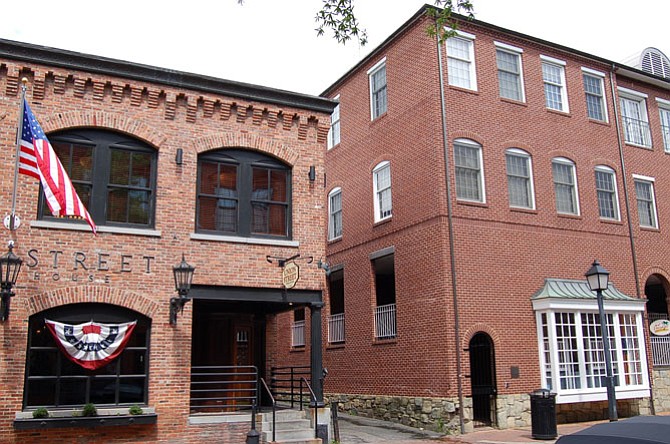The building on the left, 117-119 S. Union Street, was built in 1790. The one on the right was built in 1989. Ellen Hamilton
Alexandria — The debate rages in Alexandria about what our new waterfront should look like. It is an issue that our next mayor will be dealing with. One argument says that new buildings should fit in with existing brick buildings, mainly the two-story homes and townhouses that were built with local clay from the late 1700s to the early 1900s. This idea has been the guiding light for every building built in Alexandria for the last 20 some years. Every office building must be built with an outer brick shell.
So-called modern architecture and art have suffered under public sentiment since the early 1900s when the western world went through massive changes in thought about art and design. New ideas were a reaction to the increasingly ornate, frivolous European painting and architecture styles, baroque and rococo of the 1700s and 1800s. Patronized by a European aristocracy on the decline, painting went from dark and pompous portraits of the wealthy to bright landscapes and ordinary people by the impressionists right before the turn of the 20th century. New democratic ideas of equality of all prevailed. Photography took away the painter’s job of realistic rendering. In Europe cubist painters took imagery down to its simplest shapes and colors. Architects did the same thing. Decorative was out. Simple was in. In Berlin, Germany, geometric high rise apartment buildings by architect Walter Gropius were built to solve social problems of housing. People hated them. But artists and designers kept following this path. The conflict rages to this day and is exemplified in our own little city.
During the second world war, a lot of these older ornate buildings in Germany were destroyed. The modernist movement in Germany showed up in new buildings built in between the old ones. I first visited Frankfurt in the early ‘80s and I was struck by the beauty of an ornate sandstone building next to a glass tower. Gargoyles were reflected in the glass. I could see at a glance which was old and which was new.
In Old Town Alexandria new buildings in brick coats are placed next to old brick buildings. Sometimes the new buildings are nicely designed and look better than the old ones. Sometimes the new building is a simple brick shell that one could do without. If the new building had been built with modern materials and design, and had been put next to the old brick one, you would recognize it instantly as new and you would appreciate the older as coming from a former age.
In Glasgow, Scotland, there is an excellent museum of architecture called “The Lighthouse” (www. thelighthouse.co.uk). There I saw an exhibit showing Scotland to have the world’s largest and most diverse amount of stone and granite. Scotland has been the leading exporter of stone building materials. I saw many beautiful samples of sandstone, slate and granite. How much more visually interesting would Alexandria be if our architects were allowed to stretch their professional horizons and bring beautiful building materials to Alexandria! A successful waterfront may require, instead of asking an architectural firm to mimick “history,” allowing them to do their job.
I studied art in the late ‘80s and worked my way through the art history course meant to weed out the slackers. In the ‘90s I took the class in history of design for my design degree, and went back through the whole history of mankind again from a design perspective. I loved every bit of it. When I hear people argue about how the waterfront should look, I think it would help if the well-meaning, thoughtful people of Alexandria are sure to understand that our conundrum is not in a vacuum. Our decisions are formed by what happened before us, and will be seen by those who follow.
Ellen Hamilton is a graphic designer living in Alexandria, whose studio is called Yellow Dot Designs. She serves on the Alexandria Archaeology Commission.

